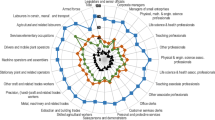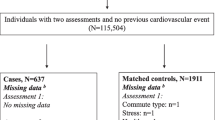Summary
Two years after an extensive health examination at a Swedish industry, a follow-up study was carried out in 110 employees (94% of those initially examined). The control included a history of the subject's health, a physical examination, an electrocardiogram, urine and faeces examinations and 16 chemical analyses of whole blood or serum. Except for repeat examinations of those who had had initial values outside reference values, most of the chemical analyses meant nothing, leading to unnecessary expense and possible risk of either worried or complacent participants. The history and physical and laboratory examinations, aimed at finding factors which can be improved by changing the life style seem to be most beneficial. It is concluded that extensive health examinations, including a large number of laboratory examinations which are carried out at many industries as a health control, should be critically evaluated at these industries.
Similar content being viewed by others
Abbreviations
- ECG:
-
electrocardiogram
- SD:
-
standard deviation
- HDL:
-
high density lipoprotein
- ASAT:
-
aspartate aminotransferase
- ALAT:
-
alanine aminotransferase
References
Alderman MH, Lamport B (1990) Labelling of hypertensives: a review of the data. J Clin Epidemiol 43:195–200
Becker MH (1986) The tyranny of health promotion. Public Health Rev 14:15–23
Burdine JN, McLeroy KB, Gottlieb NH (1987) Ethical dilemmas in health promotion: an introduction. Health Educ Q 14:7–9
Chovil AC, Altekruse EB (1986) Health promotion in occupational medicine and the primary care physician. Fam Community Health 8:29–35
Council on Scientific Affairs, Division of Scientific Activities, American Medical Association, Chicago (1983) Medical evaluations of healthy persons. JAMA 249:1626–1633
Ebeling K (1987) Screening zur Früherkennung bösartiger Neubildungen — wissenschaftliche Grundlagen, Methoden der Erfolgsbewertung und praktische Konsequenzen. Z Arztl Fortbild (Jena) 81:521–528
Flodmark BT (1989) Blodprovstagning hos anamnestiskt friska personer är bortkastade pengar. Läkartidningen 86:3134
Friedman GD, Collen MF, Fireman BH (1986) Multiphasic health checkup evaluation: a 16-year follow-up. J Chron Dis 39:453–463
Gordon J (1987) Workplace health promotion: the right idea in the wrong place. Health Educ Res 2:69–71
Haines AP, Sanders TAB (1989) Dietary advice for lowering plasma cholesterol. BMJ 298:1594–1595
Jones A, Davies DH, Dove JR, Collinson MA, Brown PMR (1988) Identification and treatment of risk factors for coronary heart disease in general practice: a possible screening model. BMJ 296:1711–1714
Kaplan GA, Camacho T (1983) Perceived health and mortality: a nine-year follow-up of the human population laboratory cohort. Am J Epidemiol 117:292–304
Lefebvre RC, Hursey KG, Carleton RA (1988) Labelling of participants in high blood pressure screening programs: implications for blood cholesterol screening. Arch Intern Med 148:1993–1997
Leitch D (1989) Who should have their cholesterol concentration measured? What experts in the United Kingdom suggest. BMJ 298:1615–1616
Maschewsky-Schneider U, Greiser E (1989) Primary prevention of coronary heart disease versus health promotion — a contradiction. Ann Med 21:215–218
Ostwald SK (1986) Cost-benefit analysis. A framework for evaluating corporate health promotion programs. AAOHN Journal 34:377–382
Rose G, Bengtsson C (1991) Evaluation of a laboratory health examination programme in a Swedish industry (Volvo). Scand J Clin Lab Invest 51:155–160
Sacks G, Marsden R (1989) Evaluation of a practice-based programme of health checks: financial cost and success at risk detection. J Royal Coll Gen Pract 39:369–372
Schilling RSF (1989) Health protection and promotion at work. Br J Ind Med 46:683–688
Schneider WJ, Stewart SC, Haughey MA (1989) Health promotion in a scheduled cyclical format. J Occup Med 31:443–446
Stoate HG (1989) Can health screening damage your health? J Royal Coll Gen Pract 39:193–195
Tunstall-Pedoe H (1989) Who is for cholesterol testing? BMJ 298:1593–1594
Tymstra T, Bieleman B (1987) The psychological impact of mass screening for cardiovascular risk factors. Fam Pract 4:287–290
Wallin L, Wright I (1986) Psychosocial aspects of the work environment: a group approach. J Occup Med 28:384–393
Warner KE, Wickizer TM, Wolfe RA, Schildroth JE, Samuelson MH (1988) Economic implications of workplace health promotion programs: review of the literature. J Occup Med 30:106–112
Author information
Authors and Affiliations
Rights and permissions
About this article
Cite this article
Rose, G., Bengtsson, C. Follow-up study of participants in an extensive health examination programme at a Swedish industry. Klin Wochenschr 69, 1146–1151 (1991). https://doi.org/10.1007/BF01815433
Received:
Revised:
Accepted:
Issue Date:
DOI: https://doi.org/10.1007/BF01815433




